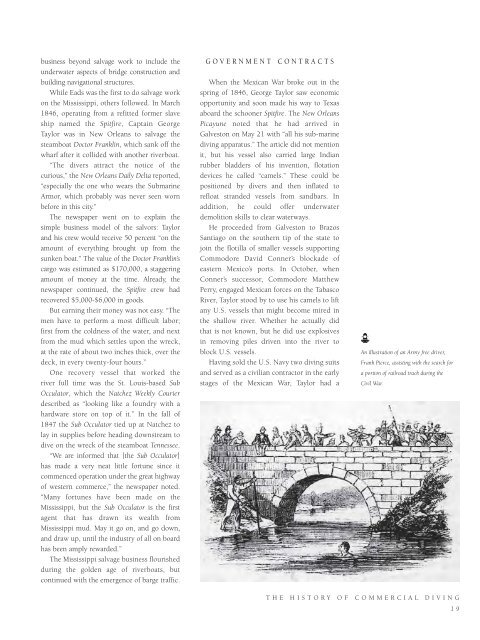Working Underwater: The Story of the Commercial Diving Industry
An illustrated history of the commercial diving industry paired with the histories of companies that have helped shape the industry.
An illustrated history of the commercial diving industry paired with the histories of companies that have helped shape the industry.
You also want an ePaper? Increase the reach of your titles
YUMPU automatically turns print PDFs into web optimized ePapers that Google loves.
usiness beyond salvage work to include <strong>the</strong><br />
underwater aspects <strong>of</strong> bridge construction and<br />
building navigational structures.<br />
While Eads was <strong>the</strong> first to do salvage work<br />
on <strong>the</strong> Mississippi, o<strong>the</strong>rs followed. In March<br />
1846, operating from a refitted former slave<br />
ship named <strong>the</strong> Spitfire, Captain George<br />
Taylor was in New Orleans to salvage <strong>the</strong><br />
steamboat Doctor Franklin, which sank <strong>of</strong>f <strong>the</strong><br />
wharf after it collided with ano<strong>the</strong>r riverboat.<br />
“<strong>The</strong> divers attract <strong>the</strong> notice <strong>of</strong> <strong>the</strong><br />
curious,” <strong>the</strong> New Orleans Daily Delta reported,<br />
“especially <strong>the</strong> one who wears <strong>the</strong> Submarine<br />
Armor, which probably was never seen worn<br />
before in this city.”<br />
<strong>The</strong> newspaper went on to explain <strong>the</strong><br />
simple business model <strong>of</strong> <strong>the</strong> salvors: Taylor<br />
and his crew would receive 50 percent “on <strong>the</strong><br />
amount <strong>of</strong> everything brought up from <strong>the</strong><br />
sunken boat.” <strong>The</strong> value <strong>of</strong> <strong>the</strong> Doctor Franklin’s<br />
cargo was estimated as $170,000, a staggering<br />
amount <strong>of</strong> money at <strong>the</strong> time. Already, <strong>the</strong><br />
newspaper continued, <strong>the</strong> Spitfire crew had<br />
recovered $5,000-$6,000 in goods.<br />
But earning <strong>the</strong>ir money was not easy. “<strong>The</strong><br />
men have to perform a most difficult labor;<br />
first from <strong>the</strong> coldness <strong>of</strong> <strong>the</strong> water, and next<br />
from <strong>the</strong> mud which settles upon <strong>the</strong> wreck,<br />
at <strong>the</strong> rate <strong>of</strong> about two inches thick, over <strong>the</strong><br />
deck, in every twenty-four hours.”<br />
One recovery vessel that worked <strong>the</strong><br />
river full time was <strong>the</strong> St. Louis-based Sub<br />
Occulator, which <strong>the</strong> Natchez Weekly Courier<br />
described as “looking like a foundry with a<br />
hardware store on top <strong>of</strong> it.” In <strong>the</strong> fall <strong>of</strong><br />
1847 <strong>the</strong> Sub Occulator tied up at Natchez to<br />
lay in supplies before heading downstream to<br />
dive on <strong>the</strong> wreck <strong>of</strong> <strong>the</strong> steamboat Tennessee.<br />
“We are informed that [<strong>the</strong> Sub Occulator]<br />
has made a very neat little fortune since it<br />
commenced operation under <strong>the</strong> great highway<br />
<strong>of</strong> western commerce,” <strong>the</strong> newspaper noted.<br />
“Many fortunes have been made on <strong>the</strong><br />
Mississippi, but <strong>the</strong> Sub Occulator is <strong>the</strong> first<br />
agent that has drawn its wealth from<br />
Mississippi mud. May it go on, and go down,<br />
and draw up, until <strong>the</strong> industry <strong>of</strong> all on board<br />
has been amply rewarded.”<br />
<strong>The</strong> Mississippi salvage business flourished<br />
during <strong>the</strong> golden age <strong>of</strong> riverboats, but<br />
continued with <strong>the</strong> emergence <strong>of</strong> barge traffic.<br />
GOVERNMENT<br />
CONTRACTS<br />
When <strong>the</strong> Mexican War broke out in <strong>the</strong><br />
spring <strong>of</strong> 1846, George Taylor saw economic<br />
opportunity and soon made his way to Texas<br />
aboard <strong>the</strong> schooner Spitfire. <strong>The</strong> New Orleans<br />
Picayune noted that he had arrived in<br />
Galveston on May 21 with “all his sub-marine<br />
diving apparatus.” <strong>The</strong> article did not mention<br />
it, but his vessel also carried large Indian<br />
rubber bladders <strong>of</strong> his invention, flotation<br />
devices he called “camels.” <strong>The</strong>se could be<br />
positioned by divers and <strong>the</strong>n inflated to<br />
refloat stranded vessels from sandbars. In<br />
addition, he could <strong>of</strong>fer underwater<br />
demolition skills to clear waterways.<br />
He proceeded from Galveston to Brazos<br />
Santiago on <strong>the</strong> sou<strong>the</strong>rn tip <strong>of</strong> <strong>the</strong> state to<br />
join <strong>the</strong> flotilla <strong>of</strong> smaller vessels supporting<br />
Commodore David Conner’s blockade <strong>of</strong><br />
eastern Mexico’s ports. In October, when<br />
Conner’s successor, Commodore Mat<strong>the</strong>w<br />
Perry, engaged Mexican forces on <strong>the</strong> Tabasco<br />
River, Taylor stood by to use his camels to lift<br />
any U.S. vessels that might become mired in<br />
<strong>the</strong> shallow river. Whe<strong>the</strong>r he actually did<br />
that is not known, but he did use explosives<br />
in removing piles driven into <strong>the</strong> river to<br />
block U.S. vessels.<br />
Having sold <strong>the</strong> U.S. Navy two diving suits<br />
and served as a civilian contractor in <strong>the</strong> early<br />
stages <strong>of</strong> <strong>the</strong> Mexican War, Taylor had a<br />
An illustration <strong>of</strong> an Army free driver,<br />
Frank Pierce, assisting with <strong>the</strong> search for<br />
a portion <strong>of</strong> railroad track during <strong>the</strong><br />
Civil War.<br />
THE HISTORY OF COMMERCIAL DIVING<br />
19
















